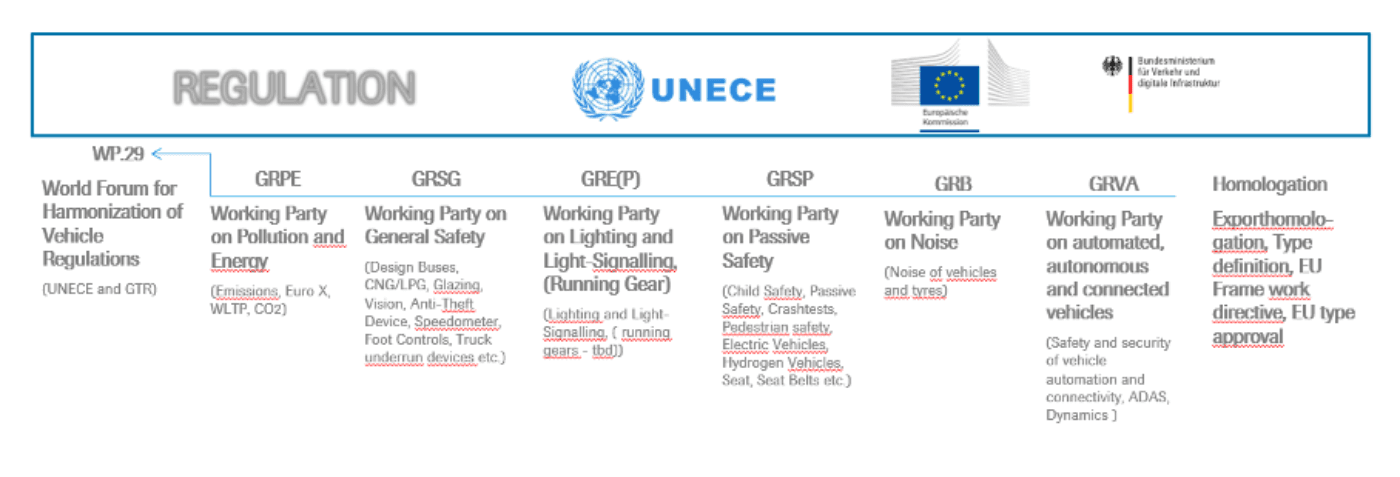- Topics
- Automotive industry
- Standardization and technical standards

Automotive industry
Norms and standards
The task of norms and standardization is to establish the state of the art as a competition-independent orientation with the aim of describing basic requirements and test methods.
The task of norms and standardization is to establish the state of the art as a competition-independent orientation with the aim of describing basic requirements and test methods.
- Topics
- Automotive industry
- Standardization and technical standards
Regulations and standardization
Standards are generally understood as technical rules that describe requirements and recommendations for the safety, design, and environmental behavior of products. In the automotive world, a distinction is made between binding regulations and voluntary industry standards:
Binding regulations primarily relate to safety and environmental aspects, compliance with which is generally stipulated by the legislator to safeguard basic social requirements. They are developed at the request of the legislator with the support of the industry.

Voluntary industry standards describe the state of the art and specify requirements for quality, safety, and interchangeability. Furthermore, they are drawn up to describe interfaces and to ensure comparability of customer-relevant properties. They are agreements that are developed on the initiative of the industry.
Due to their legal nature, these binding regulations, if they are to be valid in many countries, must be incorporated into national law by way of international agreements. The World Forum for Harmonization of Vehicle Regulations (UN ECE WP.29) has enabled the standardization of approval-related vehicle requirements by means of two agreements signed by many countries. Nevertheless, there are very different regulations and approval processes around the world (e.g., for crash behavior, exhaust emissions, lighting equipment, or braking systems) according to which vehicles must undergo type testing and approval by local authorities before they can be launched on the market.
Pre-competitive standardization
Standardization is harmonization for the benefit of the general public, carried out in a planned and collaborative manner. Norms and standards describe what is technically possible, what makes economic sense and what has been practically tested. Standardization work is based on consensus and transparency. Technical regulations promote rationalization or serve quality assurance. They describe interfaces and enable comparability for the user.
Standards must not lead to a special economic advantage for individuals. Essential components of the work organization are therefore the inclusion of a broad expert public and the consensus principle. The standardization process is transparent and guarantees the involvement of all interested parties. The process for a standards project is clearly defined.
Global coordination
Standardization work is usually industry-driven with the aim of streamlining, describing interfaces or assessing quality and function. They thus form an essential working basis for every developer and are at the beginning of every development task. Compliance with norms and standards is basically voluntary. Only in exceptional cases is compliance with norms and standards required by reference in laws and regulations. This is mainly done to meet basic safety and environmental requirements.
In Germany, Europe and the world, independent platforms have been formed that organize the creation of norms and standards and act as their publishers. In Germany, the German Institute for Standardization (DIN e.V.) organizes technical rule-making as a registered association on behalf of the German government. To fulfill this task, DIN ensures compliance with antitrust requirements by means of strict specifications.
At European and international level, similar platforms have been created in the form of CEN and ISO. These complement each other and ensure a fair and balanced approach via the delegation principle by forming national opinions and sending national experts to represent national interests at European or international level.
Through a contractual agreement with DIN, the VDA has taken over the sponsorship of the so-called external automotive technology standards committee. This agreement ensures optimum handling of the standardization experts from the automotive industry by the association's know-how, as well as compliance with the recognized rules for standardization work. The agreement obliges the sponsor to use the tools and processes provided by DIN, CEN and ISO for standardization.
The legal framework created by DIN, CEN and ISO for the drafting process is the basis for the trust and good reputation that publications by these organizations enjoy among experts. Industry follows this trust and ensures the quality of the standards and norms published by DIN, CEN and ISO by providing outstanding experts.
With the aid of various forms of publication with varying degrees of binding force, these organizations have meanwhile also ensured that the state of the art for new emerging technologies can initially be documented in technical specifications or informative reports. Through subsequent development steps, these can then be further developed into national, European and international standards.





